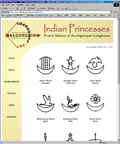| Home |
|
HISTORY
OF INDIAN PRINCESS PROGRAMS
In the Beginning...
"The
Indian father raises his son. He teaches his son to hunt, to track,
to fish, to walk softly and silently in the forest, to know the
meaning and purpose of life and all that he must know, while the
white man allows the mother to raise his son." These
chance remarks made in the early 1920s by Ojibway Indian hunting
guide Joe Friday to Harold Keltner, a St. Louis YMCA director,
struck a responsive chord.
Closing
the Gap
In 1925 Keltner arranged for Friday to speak before boys and dads in
the St. Louis area. One evening after a talk given at a father
and son banquet, Friday was so closely surrounded by fathers that
the boys could not get near him. This gave Keltner an idea.
Perhaps this strong mutual interest in the Indian could be put at
the heart of a program aimed at closing the gap that he had seen
widening between American fathers and their sons.
American
Indian Culture and Life
Keltner designed a father-son program based on the qualities of
American Indian culture and life: Dignity, Patience,
Endurance, Spirituality, Feeling for the earth, and Concern for the
family. From this, Y-Indian Guide programs were born.
Rapid
Growth After WWII
In 1926, Keltner organized the first tribe of Y-Indian Guides in
Richmond Heights, MO., with the help of Friday and William
Hefelfinger, chief of that first tribe. Although it grew
slowly at first, the program was eventually recognized as a national
YMCA program in 1935. The popularity of Y-Indian Guides grew
rapidly in the post-World War II period of 1942 to 1962, guided by
John Ledie, national advisor. Many new programs and
organizational developments at the local and national levels also
evolved during this time.
The
Y-Indian Princess program is born
The rise of the
family YMCA following World War II, the genuine need for supporting
little girls in their personal growth, and the demonstrated success
of the father-son program in turn nurtured the development of
parent-daughter groups. The
mother-daughter program, now called Indian Maidens, was established
in South Bend, IN, in 1951. Three years later father-daughter
groups, which were called Y-Indian Princesses, originated in the
Fresno, CA, YMCA. Y-Indian Braves, a program for mothers and
sons, emerged during the late 1970s and was officially recognized by
the National Executive Committee of the National Longhouse at
Dearborn, MI, in 1980.Since 1963, the swift expansion of the program
has continued with all these programs, and with a corresponding
group of programs for older children. At some point, about 900
YMCAs sponsored 30,000 Y-Indian Guide groups.
2003:
A New Beginning
In 2002 and 2003, things changed for the Algonquin Federation and
our Prairie Nation. While the local Nations and Tribes (and kids!)
were having a good time and learning, the central Y management had
plans to dramatically change the program. Meetings and surveys
ensued to figure out the future of the program. By the end of
the 2002 program year (June 2003), the members of the Algonquin
Federation voted to separate from the Y. Grand plans were made
and the Algonquin Longhouse, Inc. was formed.
The Prairie Nation is proud to be part of the Algonquin Longhouse to
further teach our children the qualities of Indian culture that Harold
Keltner envisioned over 80 years ago.
Chicago
Tribune Editorial 11/04/2002
PURPOSE, SLOGAN and AIMS
PURPOSE:
The purpose of
the Father and Daughter Y-Indian Princess Program is to foster the
understanding and companionship of father and daughter.
PLEDGE:
"We, Father and Daughter, through friendly
service to each other, to our family, to our tribe, to our
community, seek a world pleasing to the eye of the Great
Spirit."
SLOGAN:
"Friends Always"
| AIMS: |
- To love the sacred circle of my family.
- To be clean in body and pure in heart.
- To share understanding with my father/daughter.
- To listen while others speak.
- To love my neighbor as myself.
- To seek and preserve the beauty of the Great Spirit's work in
forest, field, and stream.
|
The Twelve Moons and Symbols

Please Click
Symbolism of the Indian Princess
Headband

The Indian Princess
Headband design displays significant symbols of Indian Princess
principles and purpose. The central theme of the headband is the
symbol of the eye of the Great Spirit.
The crossed arrows to the left of the central symbol symbolizes
friendship. The circled heart to the right of the central
symbol, is the symbol for love. The fathers and daughters are
symbolized next to the symbols for love and friendship which is
interpreted to mean that fathers and daughters, under the eye of the
Great Spirit, are seeking loving and friendly service to each other.
To the left are three teepees which is the symbol for community.
The line that joins this symbol with the symbol for father and
daughter, indicates the happy work of father and daughter in the
community. To the right is a single teepee, symbolizing home.
Again, a line joins this symbol with the symbol for father and
daughter, indicating happy work at home.
To the far right and left are symbols for day, night, forest,
mountain, field, lake and stream
These symbols tend to enrich the central theme, giving a broader
scope to the work of the father and daughter by centering their
efforts in village and community life, and, as the ritual says,
"In forest, field, and stream."
The meaning of the
headband has been interpreted in the words of the Indian Princess
Pledge:
"We, Father
and Daughter, through friendly service to each other, to our family,
to this tribe, to our community, seek a world pleasing to the eye of
the Great Spirit".
|

